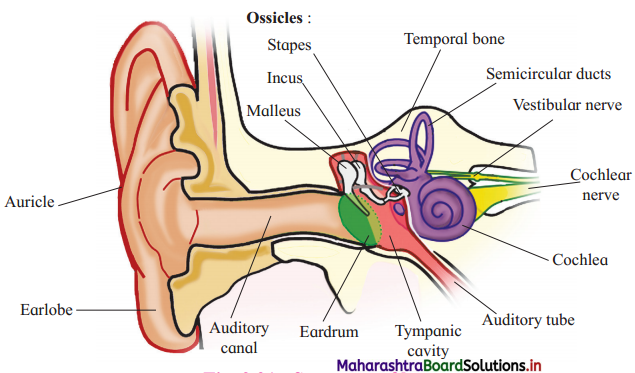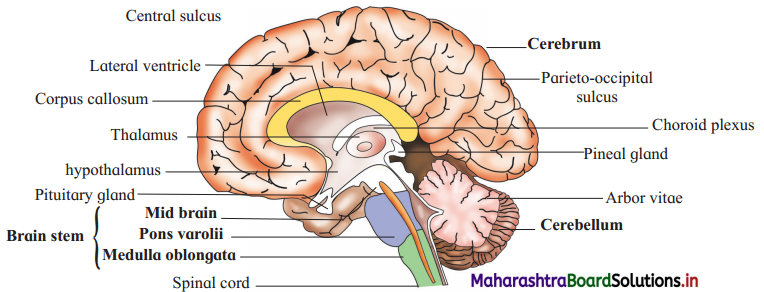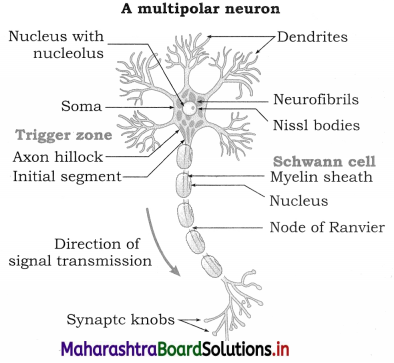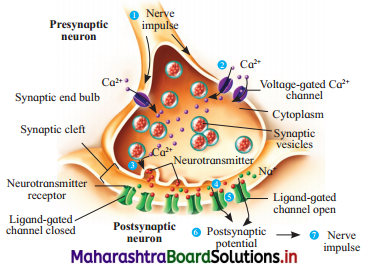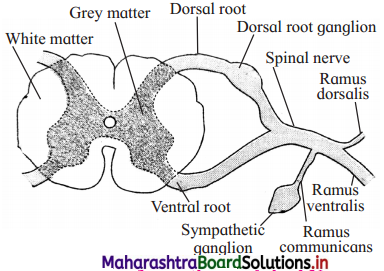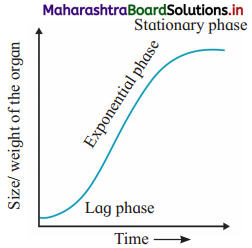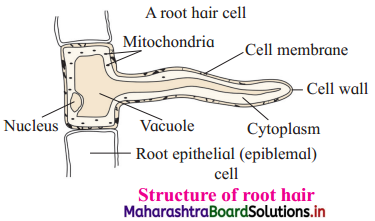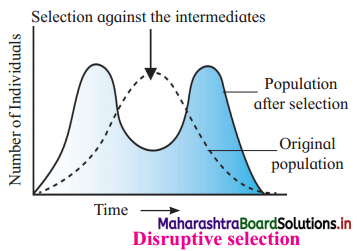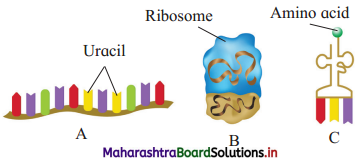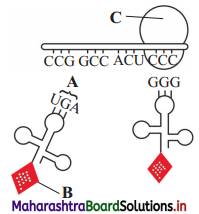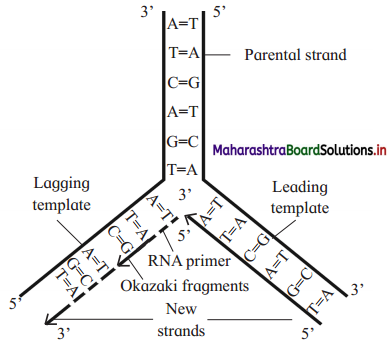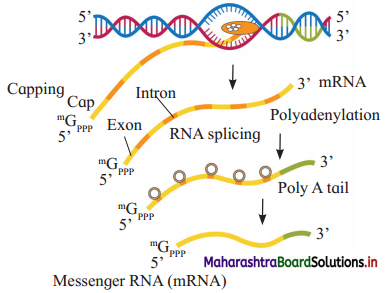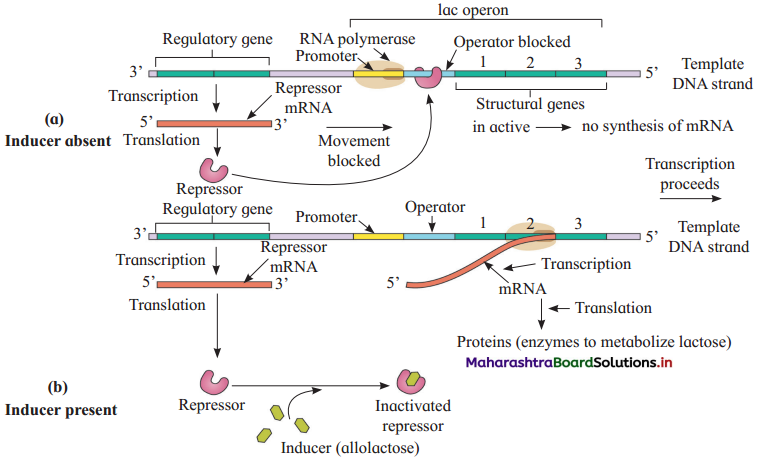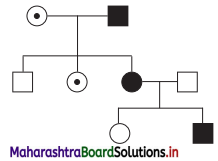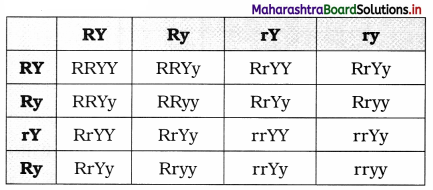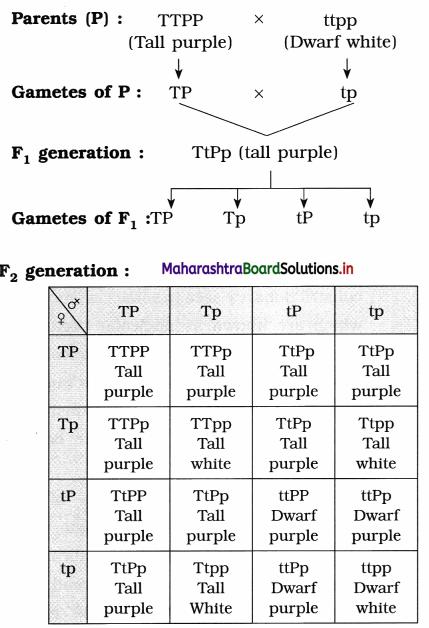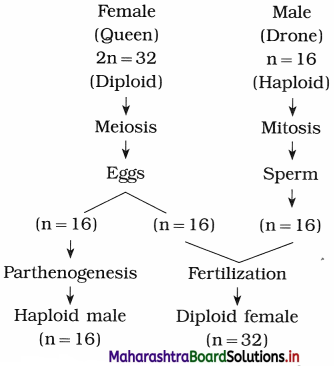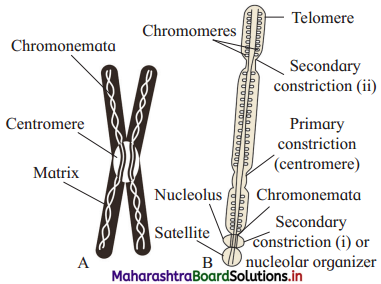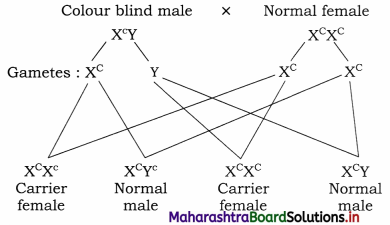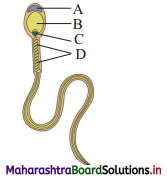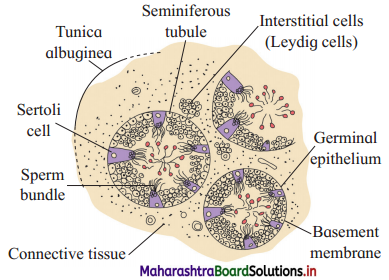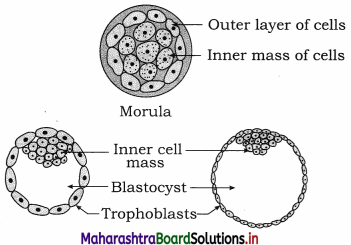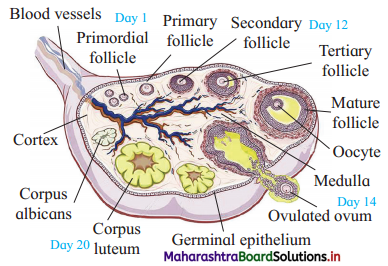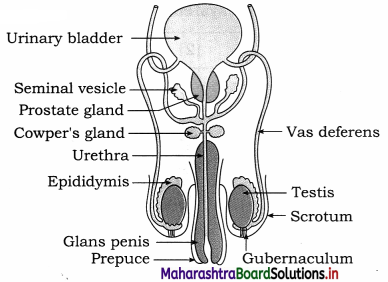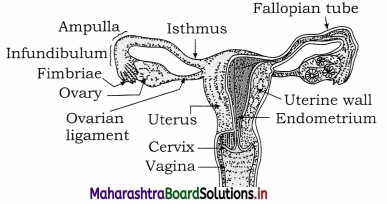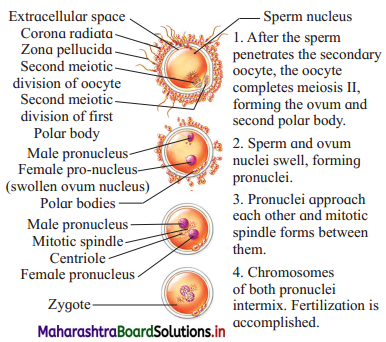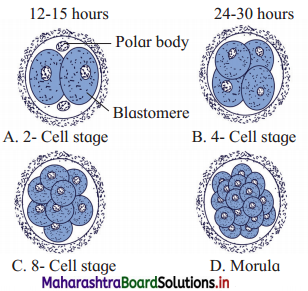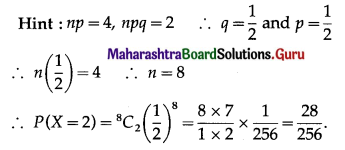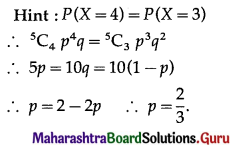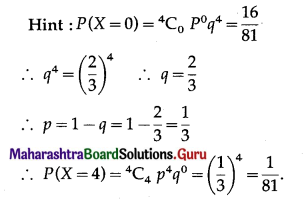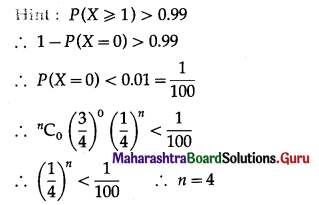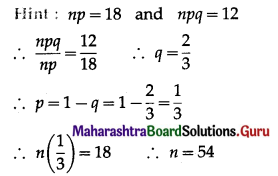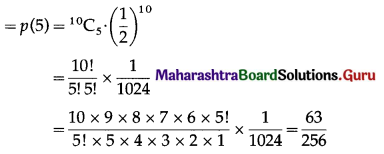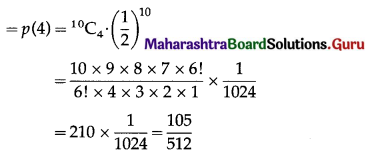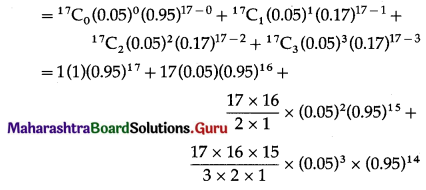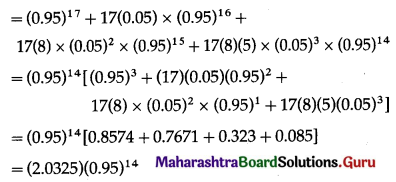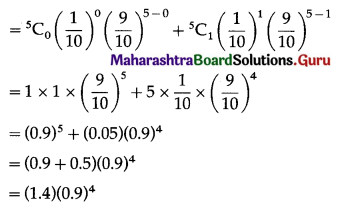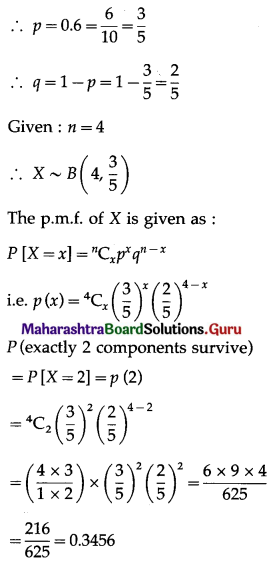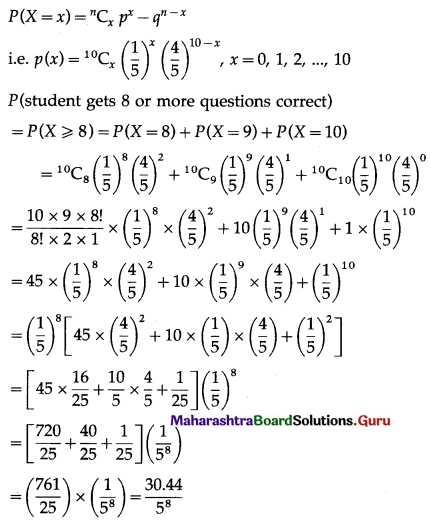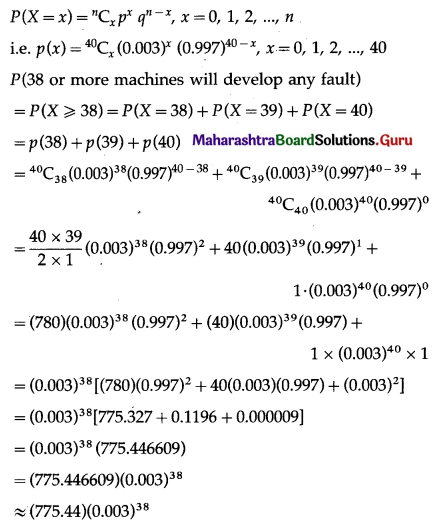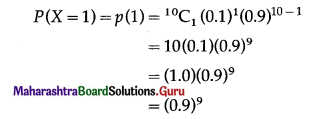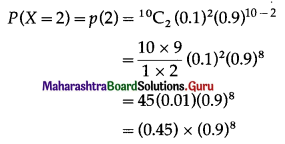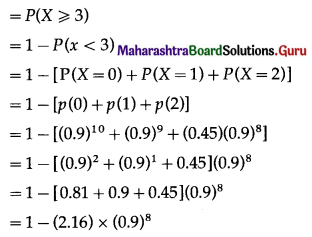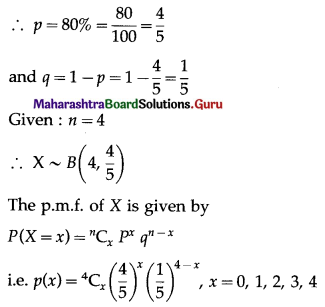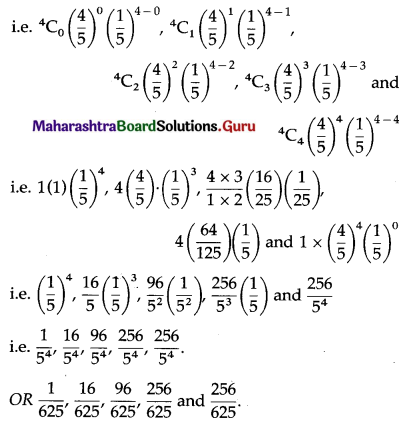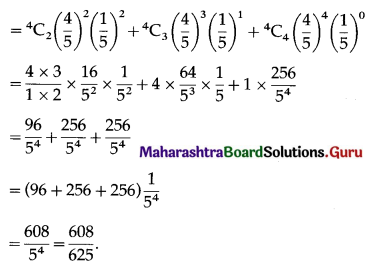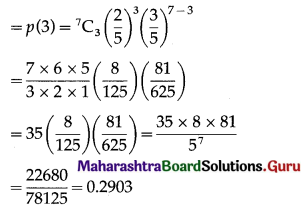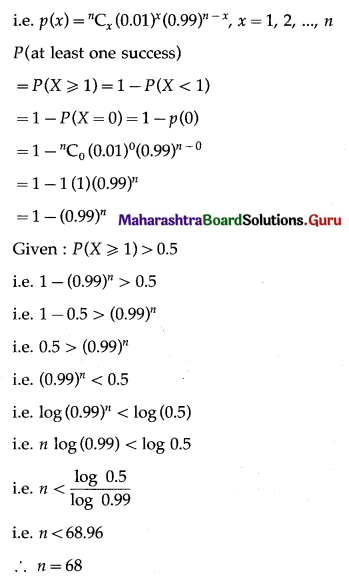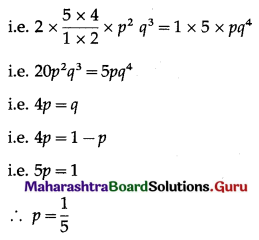Enhancement of Food Production Class 12 Exercise Question Answers Solutions Maharashtra Board
Balbharti Maharashtra State Board 12th Biology Textbook Solutions Chapter 11 Enhancement of Food Production Textbook Exercise Questions and Answers.
Class 12 Biology Chapter 11 Exercise Solutions Maharashtra Board
Biology Class 12 Chapter 11 Exercise Solutions
1. Multiple choice questions
Question 1.
Antibiotic Chloromycetin is obtained from ………………….
(a) Streptomyces erythreus
(b) Penicillium chrysogenum
(c) Streptomyces venezuelae
(d) Streptomyces griseus
Answer:
(c) Streptomyces venezuelae
Question 2.
Removal of large pieces of floating debris, oily substances, etc. during sewage treatment is called ………………….
(a) primary treatment
(b) secondary treatment
(c) final treatment
(d) amplification
Answer:
(a) primary treatment
![]()
Question 3.
Which one of the following is free living bacterial biofertilizer?
(a) Azotobacter
(b) Rhizobium
(c) Nostoc
(d) Bacillus thuringiensis
Answer:
(a) Azotobacter
Question 4.
Most commonly used substrate for industrial production of beer is ………………….
(a) barley
(b) wheat
(c) corn
(d) sugar cane molasses
Answer:
(a) barley
Question 5.
Ethanol is commercially produced through a particular species of ………………….
(a) Aspergillus
(b) Saccharomyces
(c) Clostridium
(d) Trichoderma
Answer:
(b) Saccharomyces
Question 6.
One of the free-living anaerobic nitrogen- fixers is ………………….
(a) Azotobacter
(b) Beijerinckia
(c) Rhodospirillum
(d) Rhizobium
Answer:
(c) Rhodospirillum
Question 7.
Microorganisms also help in production of food like ………………….
(a) bread
(b) alcoholic beverages
(c) vegetables
(d) pulses
Answer:
(a) bread
Question 8.
MOET technique is used for ………………….
(a) production of hybrids
(b) inbreeding
(c) outbreeding
(d) outcrossing
Answer:
(a) production of hybrids
Question 9.
Mule is the outcome of ………………….
(a) inbreeding
(b) artificial insemination
(c) interspecific hybridization
(d) outbreeding
Answer:
(c) interspecific hybridization
2. Very Short Answer Questions
Question 1.
What makes idlis puffy?
Answer:
During preparation of idlis, rice and black gram flour is fermented by air borne Leuconostoc and Streptococcus bacteria. CO2 produced during fermentation makes them puffy.
Question 2.
Bacterial biofertilizers.
Answer:
Rhizobium, Frankia, Pseudomonas striata, Bacillus polymyxa, Agrobacterium, Microccocus, Azotobacter, Costridium, Beijerinkia, Klebsiella.
Question 3.
What is the microbial source of vitamin B12?
Answer:
The microbial source of vitamin B12 is Pseudomonas denitrificans.
Question 4.
What is the microbial source of enzyme invertase?
Answer:
The microbial source of enzyme invertase is Saccharomyces cerevisiae.
Question 5.
Milk starts to coagulate when Lactic Acid Bacteria (LAB) are added to warm milk as a starter. Mention any two other benefits of LAB.
Answer:
Lactic Acid Bacteria (LAB) check the growth of disease causing microbes and produce vitamin B.
Question 6.
Name the enzyme produced by Streptococcus bacterium. Explain its importance in medical sciences.
Answer:
The enzyme produced by Streptococcus spp. is streptokinase. It is used as a ‘clot buster’ for clearing blood clots in the blood vessels in heart patients.
![]()
Question 7.
What is breed?
Answer:
Breed is a group of animals related by descent and similar in most characters like general appearance, features, size, configuration, etc.
Question 8.
Estuary
Answer:
Estuary is a place where river meets the sea.
Question 9.
What is shellac?
Answer:
Shellac is the pure form of lac obtained by washing and filtering.
3. Short Answer Questions.
Question 1.
Many microbes are used at home during preparation of food items. Comment on such useful ones with examples.
Answer:
- Many food preparations made at home involves the use of microorganisms.
- The microbes Lactobacilli are used in the preparation of dhokla from gram flour and buttermilk by the process of fermentation.
- Dosa and idlis are prepared by using batter of rice and black gram which is fermented by air borne Leuconostoc and Streptococcus bacteria.
- Large, fleshy fruiting bodies of some mushrooms and truffles are directly used as food. It is sugar free, fat free food rich in proteins, vitamins, minerals and amino acids. It is food with low calories.
- Curd is prepared by inoculating milk with Lactobacillus acidophilus. Lactic acid produced during fermentation causes coagulation and partial digestion of milk protein casein and milk turns into curd.
- Buttermilk is the acidulated liquid left after churning of butter from curd, is called buttermilk.
Question 2.
What is biogas? Write in brief about the production process.
Answer:
Biogas is a mixture of methane CH4 (50-60%), CO2 (30-40%), H2S (0-3%) and other gases (CO, N2, H2) in traces.
Biogas production process:
a. A typical biogas plant consists of digester (made up of concrete bricks and cement or steel and is partly buried in the soil) and gas holder (a cylindrical gas tank to collect gases).
b. Raw materials like cow dung is mixed with water in equal proportion to make slurry which is fed into the digester’ through a side opening (charge pit).
Anaerobic digestion involves following processes:
i. Hydrolysis or solubilization:
Anaerobic hydrolyzing bacteria like Clostridium and Pseudomonas hydrolyse carbohydrates into simple sugars, proteins into amino acids and lipids into fatty acids.
ii. Acidogenesis:
Facultative and obligate anaerobic, acidogenic bacteria convert simple organic substances into acids like formic acid, acetic acid, H2 and CO2
iii. Methanogenesis:
Anaerobic methanogenic bacteria like Methanobacterium, Methanococcus convert acetate, H2 and CO2 into Methane, CO2 and H2O and other products.
12 mol CH3COOH → 12CH4 + 12CO2 4mol H.COOH → CH4 + 3CO2 + 2H2O CO2 + 4H2 → CH4 + 2H2O
Question 3.
Biocontrol agents.
Answer:
(1) Biocontrol agents are the organisms like (bacteria, fungi, viruses and protozoans) act which are employed for controlling pathogens, pests and weeds.
(2) They cause the disease to the pest or compete or kill them.
(3) The use of biocontrol measures greatly reduces use of toxic chemicals and pesticides that are harmful to human beings and also pollute our environment.
(4) Biocontrol agents and their hosts.
- Bacteria (Bacillus thuringiensis, B. papilliae and B. lentimorbus Hosts : Caterpillars, cabbage worms, adult beetles
- Fungi (Beauveria bassiana, Entomophothora, pallidaroseum, Zoophthora radicans) Host : Aphid crocci, A. unguicilata, mealy bugs, mites, white flies, etc.
- Protozoans (Nosema locustae) Host: Grasshoppers, caterpillars, crickets
- Viruses (Nucleopolyhedro virus-NPV, Granulovirus-GV) Host : Caterpillars, Gypsy moth, ants and beetles.
(5) Some examples:
- Bacillus thuringiensis (Bt) is a microbiai pesticide used to get rid of butterfly, caterpillars.
- Trichoderma fungus is an effective biocontrol agent against soil borne fungal plant pathogens which infect roots and rhizomes.
- Phytophthora palmiuora is a mycoherbicide that controls milk weed in orchards.
- Pseudomonas spp. is a bacterial herbicide that attacks several weeds.
- Tyrea moth controls the weed Senecio jacobeac.
Question 4.
Name any two enzymes and antibiotics with their microbial source.
Answer:
- Microbial source of Chloromycetin. – Streptomyces venezuelae
- Microbial source of Erythromycin. – Streptomyces erythreus
- Microbial source of Penicillin. – Penicillium chrysogenum
- Microbial source of Streptomycin. – Streptomyces griseus
- Microbial source of Griseofulvin. – Penicillium griseojulvum
- Microbial source of Bacitracin. – Bacillus licheniformis
- Microbial source of Oxytetracyclin / Terramycin. – Streptomyces aurifaciens
- The enzyme produced by Streptococcus bacterium. – Streptokinase
- Microbial source of Invertase. – Saccharomyces cerevisiae
- Microbial source of Pectinase. – Sclerotinia libertine, Aspergillus niger
- Microbial source of Lipase. – Candida lipolytica
- Microbial source of Cellulase. – Trichoderma konigii
![]()
Question 5.
Write the principles of farm management.
Answer:
The principles of farm management are as follows:
- Selection of high-yielding breeds.
- Understanding the feed requirements of farm animals.
- Supply of adequate nutritional sources for the animals.
- Maintaining the cleanliness of environment.
- Maintenance of health with the help of veterinary supervision.
- Undertaking vaccination programmes.
- Development of high-yielding cross-bred varieties.
- Making various products and their preservation.
- Distribution and marketing of the farm produce.
Question 6.
Give the economic importance of fisheries.
Answer:
Economic importance of fisheries is as follows:
- Fish is a nutritious food and thus is a source of many vitamins, minerals and nutrients.
- Commercial products such as fish oil, fish meal and fertilizers, fish guano, fish glue, isinglass are prepared from fish.
- These by-products are used in paints, soaps, oils and medicines.
- Some organisms like prawns and lobsters have high export value and market price.
- Fish farming and other fishery trades provide job opportunity and self-employment
- Productivity and national economy is improved through fishery practices.
Question 7.
Enlist the species of honey bee mentioning their specific uses.
Answer:
(1) The four species of honey bees commonly found in India : Apis dorsata (rock bee, or wild bee), Apis jlorea (little bee), Apis mellifera (European bee) and Apis indica (Indian bee).
(2) Uses:
- Rock bee : They produce 36 kg of honey per comb per year. They produce bee wax.
- Little bee : They produce half kg of honey per hive per year.
- European bee : The average production per colony per year is 25 to 40 kg.
- Indian bee : The average production per colony per year is 6 to 8 kg.
Question 8.
What are A, B, C, D in the table given below.
| Types of microbe | Name | Commercial Product |
| Fungus | A | Penicillin |
| Bacterium | Acetobacter aceti | B |
| C | Aspergillus niger | Citric acid |
| Yeast | D | Ethanol |
Answer:
A : Penicillium chrysogenum
B : Vinegar (Acetic acid)
C : Fungus
D : Sachharomyces cerevisiae var. ellipsoidis
4. Long Answer Questions.
Question 1.
Explain the process of sewage water treatment before it can be discharged into natural bodies. Why is this treatment essential?
Answer:
Sewage treatment includes following steps:
(1) Preliminary Treatment:
- Screening: The larger suspended or floating objects are filtered and removed in screening chambers by passing the sewage through screens or net in the chambers.
- Grit Chamber : Filtered sewage is passed into series of grit chambers which contain large stones (pebbles) and brick-ballast. Coarse particles which settle down by gravity are removed.
(2) Primary treatment (physical treatment):
- The sewage water is pumped into the primary sedimentation tank where 50-70% of the suspended solid or organic matter get sedimented and about 30-40% (in number) of coliform organisms are removed.
- The organic matter which is settled down is called primary sludge.
- Primary sludge is removed by mechanically operated devices.
- Dissolved organic matter and micro-organisms in the supernatant (effluent) are then removed by the secondary treatment.
(3) Secondary treatment (biological treatment):
- The primary effluent is passed into large aeration tanks where it is constantly agitated mechanically and air is pumped into it.
- The mesh like masses of aerobic bacteria, slime and fungal hyphae, known as floes are formed.
- Aerobic microbes consume most of the organic matter and this reduces BOD (Biochemical Oxygen Demand) of the effluent.
![]()
(4) Tertiary treatment:
- Once the BOD is sufficiently reduced, waste water is passed into a settling tank where the floes are allowed to sediment.
- The sediment is called activated sludge.
- Small part of activated sludge is transferred to aeration tank and the major part is pumped in to large anaerobic sludge digesters.
- In these tanks, anaerobic bacteria grow and digest the bacteria and fungi in the sludge and gases like methane, hydrogen sulphide, CO2, etc. are released.
- Effluents from these digesters are released in natural water bodies like rivers and streams after chlorination which kills pathogenic bacteria.
- Digested sludge is then disposed.
Question 2.
Lac culture.
Answer:
- Lac is a pink coloured resin secreted by dermal glands of female lac insect (Trachardia lacca) that hardens on coming in contact with air forming lac.
- Lac is a complex substance having resin, sugar, water, minerals and alkaline substances.
- Lac insect is colonial in habit and it feeds on succulent twigs like ber, peepal, palas, kusum, babool,
- These plants are artificially inoculated in order to get better and regular supply of good quality and quantity of lac.
- Natural lac is always contaminated and pure form of lac obtained by washing and filtering is called as shellac.
- Lac is used to make bangles, toys, woodwork, inks, mirrors, etc.
- India’s share is 85% of total lac produced in the world.
Question 3.
Describe various methods of fish preservation.
Answer:
- Fish is a highly perishable commodity.
- After catching the fish it immediately starts spoilage process.
- In order to prevent this process, the fish preservation is done.
The different methods of fish preservation are as follows:
- Chilling : This involves covering the fish with layers of ice. Ice is effective for short term preservation. It inhibits the activity of autolytic enzymes.
- Freezing : It is a long duration preservation method. Fish are freezed at 0°C to -20°C. This also inhibit autolytic enzyme activities and slows down bacterial growth.
- Freeze drying : The deep frozen -fish at -20°C are dried by direct sublimation of ice to water vapour with any melting into liquid water. This is achieved by exposing the frozen fish to 140°C in a vacuum chamber. The fish is then packed or canned in dried condition.
- Sun drying : This inhibits the growth of microorganisms that spoil the fish.
- Smoke drying : Smoke is prepared by burning woods with less resinous matter. Bacteria are destroyed by the acid content of the smoke. Smoking also give the characteristic colour, taste and odour to fish.
- Salting : Salt removes the moisture from the fish tissues by osmosis. High salt concentration destroys autolytic enzymes and halts bacterial activity.
- Canning : Canning involves sealing the food in a container, heat ‘sterilising’ the sealed unit and cooling it to ambient temperature for subsequent storage.
Question 4.
Give an account of poultry diseases.
Answer:
Various poultry diseases are as follows:
- Viral diseases : Ranikhet, Bronchitis, Avian influenza (bird flu), etc. Bird flu had serious impact on poultry farming and also caused human infection.
- Bacterial diseases : Pullorum, Cholera, Typhoid, TB, CRD (chronic respiratory disease), Enteritis, etc.
- Fungal diseases : Aspergillosis, Favus and Thrush.
- Parasitic diseases : Lice infection, round worm, caecal worm infections, etc.
- Protozoan diseases : Coccidiosis.
Question 5.
Give an account of mutation breeding with examples.
Answer:
- Mutations are sudden heritable changes in the genotype.
- Natural mutations occur at a very slow rate.
- Natural physical mutagens include exposure to high temperature, high concentration of C02, X-rays, UV rays.
- Mutations can be induced by using various mutagens.
- Mutagens cause gene mutations and chromosomal aberrations.
- Chemical mutagens include nitrous acid, EMS (Ethyl – Methyl – Sulphonate), mustard gas, colchicine, etc.
- Seedlings or seeds are irradiated by using CO60 or UV bulbs or X-ray machines.
- The mutated seedlings are then screened for resistance to diseases/pests, high yield, etc.
- Examples of mutant varieties in different crops are Jagannath (rice), NP 836 (rust resistant wheat variety), Indore-2 (cotton variety resistant to bollworm), Regina-II (cabbage variety resistant to bacterial rot).
![]()
Question 6.
Describe briefly various steps of plant breeding methods.
Answer:
The main steps of the plant breeding program (Hybridization) are as follows:
(1) Collection of variability:
- Germplasm collection is the entire collection of all the diverse alleles for all genes in a given crop.
- Wild species and relatives of the cultivated species having desired traits are collected and preserved.
- Forests and natural reserves are the means of in situ conservation of germplasm.
- Botanical gardens, seed banks, etc. are means of ex situ conservation of germplasm.
(2) Evaluation and selection of parents:
- The collected germplasm is evaluated to identify healthy and vigorous plants with desirable and complementary characters.
- Selected parents are selfed for three to four generations to increase homozygosity.
- Only pure lines are selected, multiplied and used in the hybridization.
(3) Hybridization:
- The variety showing maximum desirable features is selected as female (recurrent) parent and the other variety which lacks good characters found in recurrent parent is selected as male parent (donor).
- The pollen grains from anthers of male parent are artificially dusted over stigmas of emasculated flowers of female parent.
- Hybrid seeds are collected and sown to grow F1 geneartion.
(4) Selection and Testing of Superior Recombinants:
- The F1 hybrid plants which are superior to both the parents and having high hybrid vigour, are selected and selfed for few generations to make them homozygous for the said desirable characters.
- This ensures that there is no further segregation of the characters.
(5) Testing, release and commercialization of new cultivars:
- The newly selected lines are evaluated for the productivity and desirable features like disease resistance, pest resistance, quality, etc.
- They are initially grown under controlled conditions of water, fertilizers, etc. and their performance is recorded.
- The selected lines are then grown for at least three generations in natural field, in different agroclimatic zones.
- Finally variety is released as new variety for use by the farmers.
Maharashtra State Board 12th Std Biology Textbook Solutions
- Control and Co-ordination Class 12 Biology Textbook Solutions
- Human Health and Diseases Class 12 Biology Textbook Solutions
- Enhancement of Food Production Class 12 Biology Textbook Solutions
- Biotechnology Class 12 Biology Textbook Solutions
- Organisms and Populations Class 12 Biology Textbook Solutions
- Ecosystems and Energy Flow Class 12 Biology Textbook Solutions
- Biodiversity, Conservation and Environmental Issues Class 12 Biology Textbook Solutions
